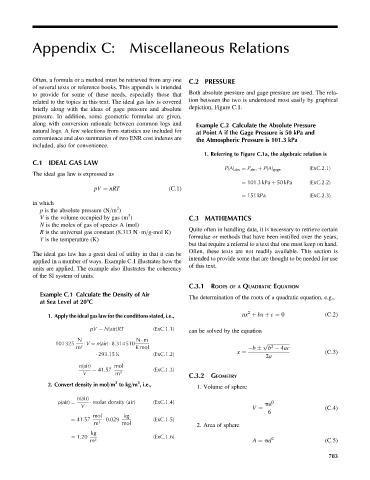Page 828 - Fundamentals of Water Treatment Unit Processes : Physical, Chemical, and Biological
P. 828
Appendix C: Miscellaneous Relations
Often, a formula or a method must be retrieved from any one C.2 PRESSURE
of several texts or reference books. This appendix is intended
to provide for some of these needs, especially those that Both absolute pressure and gage pressure are used. The rela-
related to the topics in this text. The ideal gas law is covered tion between the two is understood most easily by graphical
briefly along with the ideas of gage pressure and absolute depiction, Figure C.1.
pressure. In addition, some geometric formulae are given,
along with conversion rationale between common logs and Example C.2 Calculate the Absolute Pressure
natural logs. A few selections from statistics are included for at Point A if the Gage Pressure is 50 kPa and
convenience and also summaries of two ENR cost indexes are the Atmospheric Pressure is 101.3 kPa
included, also for convenience.
1. Referring to Figure C.1a, the algebraic relation is
C.1 IDEAL GAS LAW
(ExC:2:1)
P(A) abs ¼ P atm þ P(A) gage
The ideal gas law is expressed as
¼ 101:3 kPa þ 50 kPa (ExC:2:2)
pV ¼ nRT (C:1)
¼ 151 kPa (ExC:2:3)
in which
2
p is the absolute pressure (N=m )
3
V is the volume occupied by gas (m ) C.3 MATHEMATICS
N is the moles of gas of species A (mol)
Quite often in handling data, it is necessary to retrieve certain
R is the universal gas constant (8.313 N m=g-mol K)
formulae or methods that have been instilled over the years,
T is the temperature (K)
but that require a referral to a text that one must keep on hand.
Often, these texts are not readily available. This section is
The ideal gas law has a great deal of utility in that it can be
intended to provide some that are thought to be needed for use
applied in a number of ways. Example C.1 illustrates how the
of this text.
units are applied. The example also illustrates the coherency
of the SI system of units.
C.3.1 ROOTS OF A QUADRATIC EQUATION
Example C.1 Calculate the Density of Air
The determination of the roots of a quadratic equation, e.g.,
at Sea Level at 208C
2
1. Apply the ideal gas law for the conditions stated, i.e., ax þ bx þ c ¼ 0 (C:2)
pV ¼ N(air)RT (ExC:1:1)
can be solved by the equation
N N m
101325 V ¼ n(air) 8:314510 p ffiffiffiffiffiffiffiffiffiffiffiffiffiffiffiffiffiffi
m 2 K mol b 4ac
2
b (C:3)
293:15 K (ExC:1:2) x ¼ 2a
n(air) mol
¼ 41:57 (ExC:1:3)
V m 3
C.3.2 GEOMETRY
3
3
2. Convert density in mol=m to kg=m , i.e.,
1. Volume of sphere
n(air)
molar density (air) (ExC:1:4) 3
V (C:4)
r(air) ¼ pd
6
V ¼
mol kg
¼ 41:57 0:029 (ExC:1:5)
m 3 mol
2. Area of sphere
kg
¼ 1:20 3 (ExC:1:6) 2
m A ¼ pd (C:5)
783

